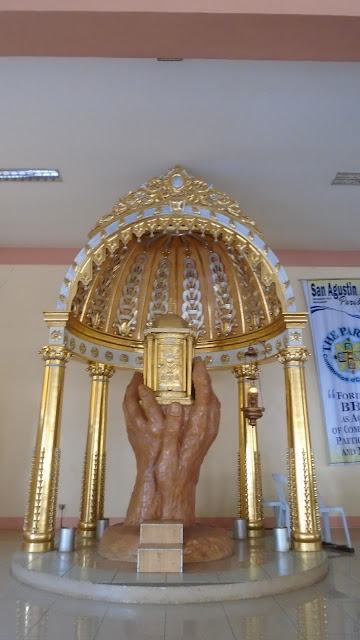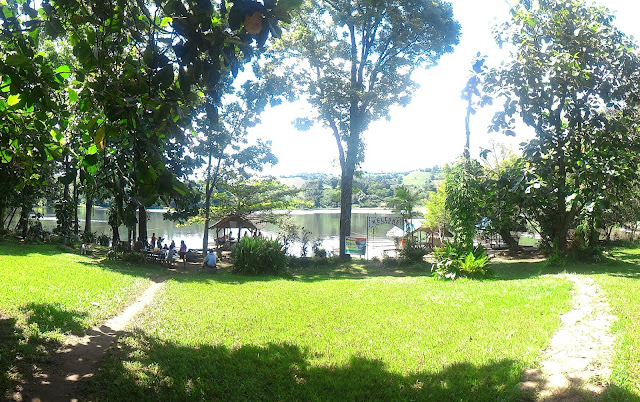Unlike
in Luzon or Visayas, the churches in Bukidnon are relatively new. The evangelization of the native tribes of Central Mindanao highlands which became the province of Bukidnon began towards the middle of the 19th century. It was started first by a Spanish Agustinian Recollect. In 1876, in accordance with an earlier royal decree, the Jesuits took over as they were entrusted with the whole of Mindanao as their mission area. There are only three parishes that
have been established prior to the 1900s, the oldest one being erected in 1830 (Impasugong)
and two others (Malaybalay and Sumilao) in 1878. The rest of the parishes were
established already in the twentieth century.
Hence the church buildings are already of modern structure.
The first church that we visited when we started the tour around the mountainous province was the parish church of the town of Manolo Fortich. Then we passed by the church of the town of Sumilao.
Immaculate Conception Parish Church
Manolo Fortich, Bukidnon
Founded: 1954
Christ the King Parish Church
Kisolom, Sumilao, Bukidnon
Founded: 1878
The next stop was the Cathedral of Malaybalay. The altar has a three-columned retablo with a crucifix at the center. There were flower stalls with tarpaulin roofing in front of the Cathedral which obstructed the view of the facade since the church was not tall enough. Perhaps they were just temporary as it was the feast of the All Souls Day.
San Isidro Cathedral Parish
Malaybalay City, Bukidnon
Founded: 1878
The Bishop's residence
From the Cathedral we passed by their new city hall which was on sprawling space just outside the city proper.
The
next stop was the parish church of the city of Valencia. It had a beautiful altar
retablo. The tabernacle at the side of the church altar was uniquely surmounted on a concrete sculpture of a pair of hands.
We then visited the Mindanao Central University which was already in the next town of Maramag. There was a parish church within the territory of the university which we also visited.
Lake Apo was the next stop in Sitio
Lawa, Guinuyoran, Valencia City. One has to pass a rough road for about three kilometres
before reaching the lake. It was a small serene lake with a beautiful view.
There were some bamboo rafts that could be rented and which could be pulled to
the middle of the lake for picnic for a very relaxing day at the lake. They also had other water rides like kayaks and jetski.
From Lake Apo we went to the church of Maramag dedicated to St. Andrew the Apostle. From there we went to the Don Carlos and visited the Sto. Niño Parish Church.
San Agustin Parish Church
Valencia City, Malaybalay
Founded: 1952
We then visited the Mindanao Central University which was already in the next town of Maramag. There was a parish church within the territory of the university which we also visited.
San Isidro Labrador Parish Church
Musuan, Maramag, Bukidnon
From Lake Apo we went to the church of Maramag dedicated to St. Andrew the Apostle. From there we went to the Don Carlos and visited the Sto. Niño Parish Church.
San Andres Parish Church
Maramag, Bukidnon
Founded: 1947
Sto. Niño Parish Church
Don Carlos, Bukidnon
San Vicente Ferrer Parish Church
Kitaotao, Bukidnon
Sto. Niño Parish Church
Dangcagan, Bukidnon
Immaculate Conception Parish
Kibawe, Bukidnon
Our Lady of the Holy Rosary Parish
Damulog, Bukidnon
From Kadilingan we then took another road which led us back to Don Carlos from where we proceeded to go to the town of Quezon which was already along the road going to Davao. It was the last town we visited and we returned to Malaybalay to stay overnight at the Bishop’s residence.
Nuestra Señora del Pilar Parish
Quezon, Bukidnon
Founded: 1965
After breakfast at the Bishop's residence, we bid goodbye to Bp. Cabantan who was our host and proceeded to the Transfiguraton Abbey about five kilometers from the city proper of Malaybalay.
From Malaybalay we made our way back to Camp JMC in Manolo Fortich. Along the way we passed by the town of Impasug-ong.
The municipal hall of Impasugong.
Immaculate Conception Parish
Impasugong, Bukidnon
Founded: 1830
The church altar opened to a garden and a grotto of the Our Lady of Lourdes at the back.
The church altar opened to a garden and a grotto of the Our Lady of Lourdes at the back.
We had our lunch at the Clubhouse of the Golf Cours of Del Monte plantation at the invitation of some RSM Sisters who had been assigned to Leyte before. After
lunch we went to the last town to be visited, the town of Libona. I was
surprised to find out that the parish church was not in the town itself but in
another barrio called Crossing. Only a chapel was in the town proper.
The 18-hole golf course at the Del Monte Golf Club, Kawayanon, Manolo Fortich, Bukidnon
Jesus Nazareno Parish
Crossing, Libona, Bukidnon
Founded: 1980
Before going back to Camp Jmc we visited the Kampo Juan, another eco-adventure park, in Brgy.
Dicklum, Manolo Fortich. Discovered just before reaching Kampo Juan, the marker of the former site of the old US Airforce del Monte Airfield where Gen. Douglas
Macarthur took the plane escaping to Australia during the Second World War. It was here where he uttered
the words "I shall return".
At the Kampo Juan they had a
heritage house which was actually taken piece by piece from a 1910 house in
Rosales, Pangasinan and assembled back in the place. There were a number of thrilling adventure activities like anicycling, ziplining, rappeling and a walk on a hanging bridge at the Kampo Juan.
Marker of the former US Airforce Del Monte Airfield
Antique memorabilias found in the Heritage house.
A hanging steel bridge one passes through after taking the zipline at the Kampo Juan.
Near
Camp JMC (James McCrawford) of the Del Monte plantation where my nephew resides
are two parishes. One is the Our Lady of Lourdes at Camp Phillips, Manolo
Fortich which is the mother parish of the San Isidro chapel at Camp JMC. Camp Phillips which is the center of the pineapple plantation, although belonging to the town of Manolo Fortich is like a town itself complete with a parish church, a big plaza with a football field and tennis court, grocery stores, a private Catholic school for elementary and high school and even a post office. The
other is the Immaculate Conception Parish in Mabilag, Manolo Fortich where my
nephew would go to hear mass when there is no service at the Camp JMC Chapel.
Our Lady of Lourdes Parish
Camp Phillips, Manolo Fortich, Bukidnon
St. Jude Thaddeus Parish
Damilag, Manolo Fortich
Founded: 2010
The church tower as seen from below.
The San Isidro Labrador Chapel at Camp JMC where I celebrated the Sunday mass.
The
Del Monte Pineapple Philippines is the biggest pineapple plantation in the Far East.
It encompasses 26,000 hectares of land which covers four towns of Manolo
Fortich, Impasug-ong, Sumilao and Libona.
Its regular employees are given free accommodations in the different camps scattered throughout the plantation
with free water and electricity. However, before an employee becomes permanent,
even if he has a managerial position, he has to work in the fields with the other laborers for
one year working from before sunrise till dusk learning the ropes of the craf,t from
field preparation, to planting until harvesting, for them to know first-hand
the life cycle of the pineapple plant.
Had the opportunity to bike around in some areas of the pineapple plantation.
The house being used by my nephew in Camp JMC. All the houses in the camp are of the same built. The houses in Camp Phillips are made of concrete.
DAHILAYAN ADVENTURE PARK
Brgy. Dahilayan, Manolo Fortich, Bukidnon
On our way back to Cagayan de Oro, we passed by the last parish church in
Bukidnon, the parish of Sto. Niño in Alae, Manolo Fortich.
Sto. Niño Parish
Alae, Manolo Fortich
Founded: 2008
Map of the towns of Bukidnon that I was able to visit.




















































































